Bathroom Towel Selection Guide
In Europe, in the early 1900s, plumbing was no longer the privileges of the elite, the conveniences of modern life were becoming available to more and more people. If we talk about Russia, then many of its regions are characterized by a rather humid climate, which is probably why their residents were so important to be able to hang clothes on a radiator so that they would dry out. And someone just got tired of banging their teeth from the cold, getting out of the bathroom, and getting new disappointment in the form of a cold, wet and, probably, emitting not the most pleasant smell of a towel. Maybe it was a deliberate action, or maybe the towel was just accidentally left on a radiator once, but at one point the idea of a heated towel rail was born.
A lot of water has flowed since then, and heated towel rails have turned from a luxury item that only luxury hotels could boast of into an affordable element of domestic comfort. People have found towel warmers a useful invention, and not just for towel drying. Towel dryers are no longer “riveted” to the bathroom: they are increasingly found in kitchens, bedrooms, hallways and basements, where they provide additional heat, reduce air humidity and thereby prevent mold.
Achievements in the field of design and engineering gave us not only beautiful, but also highly efficient devices designed for every taste and designed for various purposes. Our guide, we hope, will help you navigate the many offers of the market. You can find the perfect heated towel rail that will make you wonder how you did without it before!
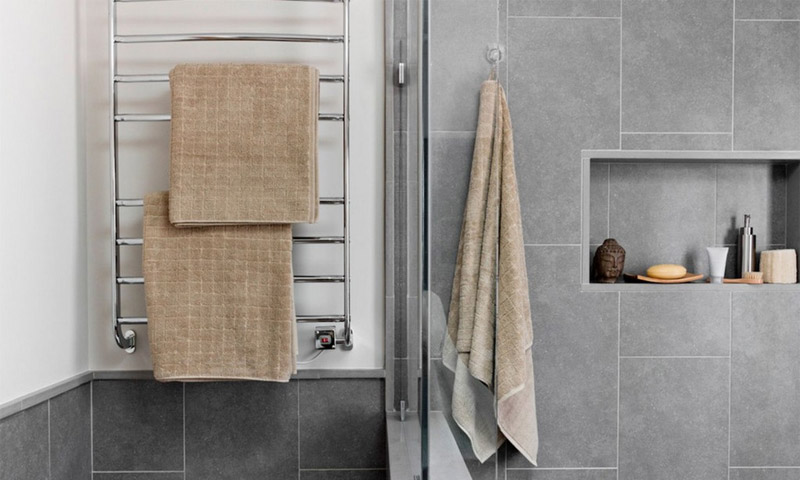
Content:
Before proceeding with the selection of a heated towel rail, try to answer the following questions:
- How much money are you willing to spend on this purchase?
- Do you need a designer model or a simple budget option?
- Do you know the benefits of electric and water towel warmers?
- Which heated towel rail will better suit your needs - rigidly mounted on the wall or freely movable?
- Should you prefer simple, smooth lines, or should you choose a more eccentric design?
- Which towel rail design will fit better in your bathroom?
Price range
Today's market allows you to make choices in a wide range of prices. Whether you are looking for a device that is not too expensive or, on the contrary, with a unique, sophisticated design, you can definitely find what you need. Towel dryers these days are available for almost any budget.
The price of heated towel rails may vary depending on their style, size and type. Many manufacturers offer a budget line of towel warmers that are available for less than $ 300, as well as impressive, first-class devices with designer finishes that can cost more than $ 4000. The first step in choosing a heated towel rail is to try to estimate the amount you are willing to part with.
What to choose an electric or water heated towel rail
After the purchase amount has been determined, it is necessary to determine the type of heated towel rail. There are two main types of heated towel rails - electric and water - and both are quite effective.
Electric heated towel rails
Electric towel dryers, as a rule, do not consume much electricity, many of them are comparable in power to a conventional electric bulb. Inside such heated towel rails, a dry heater or heated liquid, usually mineral oil, is placed. Many electric heated towel rails are equipped with an on / off button, and you can use this button exclusively to start them, rather than plugging the plug into a power outlet each time. When installing such devices, all wiring can be hidden from prying eyes. Some large units are able to generate enough heat to heat the room, although for the most efficient heating of the air in the room, electric towel warmers are usually used in combination with other sources of thermal energy.
It is good to use electric heated towel rails in the following cases:
- You are doing major repairs, but do not want to invade the existing water supply system.
- You want to have another additional heated towel rail, which will help you out during the seasonal shutdown.
- You need to use a heated towel rail not only in the bathroom but also in other rooms. In this case, you will need a mobile, portable heated towel rail, which we will discuss later.
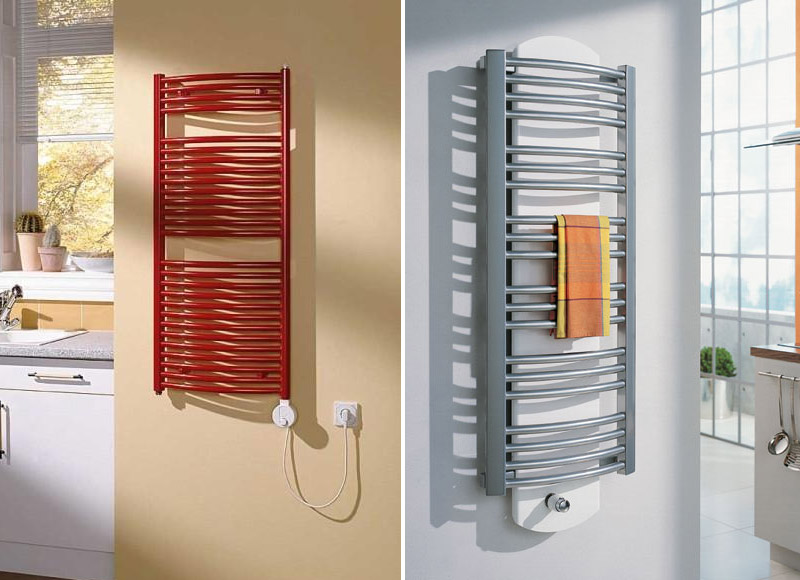
Water towel warmers
Water models generate heat using hot water that passes through a heated towel rail. Connection can be made in one of two ways - to the hot water supply of your apartment or house (open system) or to an autonomous heating system (closed system). In most cases, a heated towel rail may be the most effective method of saving energy. However, it can be difficult to install it if it is not initially included in the system during the construction of a house or in the process of major repairs of a room, and this should be remembered when thinking about how to choose a water heated towel rail for the bathroom.
Connecting a heated towel rail to the heating system has certain disadvantages. For example, during the period when the heating is turned off, you will lose this heat source. Therefore, in cases where you use a gas column to heat water, it makes sense to look at the electric models.
If the device is connected to an autonomous heating system or hot water supply of your home, then there are no special requirements for the operational characteristics of the heated towel rail. The main and only indicator that you need to pay attention to is the maximum pressure that the device is designed for. In the autonomous heating system of a private house, the pressure is not great, so in this case, the choice of the type of heated towel rail is quite extensive and you can install any model you like.
However, if it is planned to connect to a centralized hot water supply system, the vast majority of imported heated towel rails will not work. The fact is that the pressure in the hot water supply systems of apartment buildings is 8-10 atmospheres, although in most buildings of the old fund it does not exceed 5-7 atmospheres. At the same time, the wall thickness of the pipe, given towel warmers, is only 1-1.25 mm. and they all have a slight working pressure. Depending on the aggressiveness of hot water in the DHW system, the service life of such a device will be 1.5-2 years. In the best case, you just have to replace the device, in the worst, do repairs to the flooded neighbors from below.
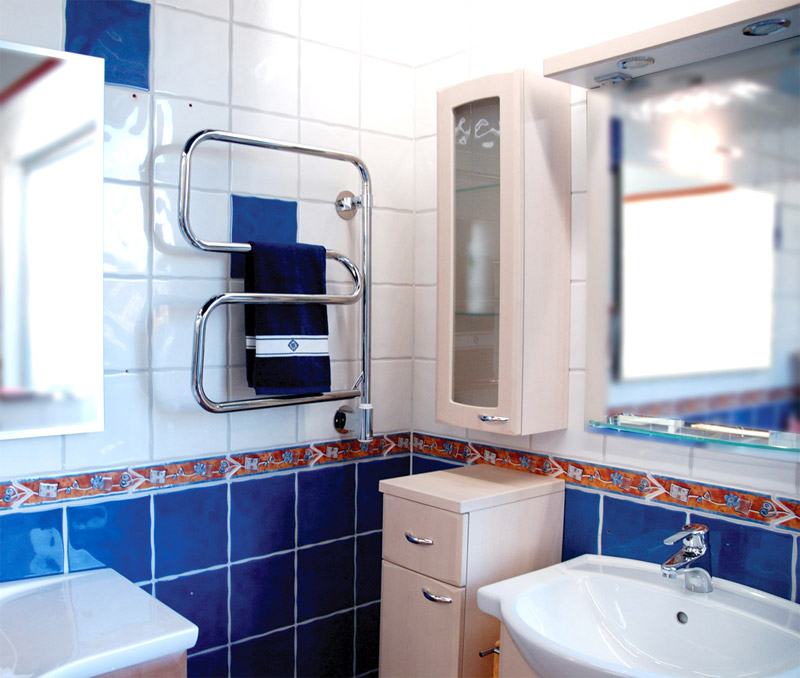
How to choose a water heated towel rail for a central hot water system
The choice of material
There are three most common metals that are used in the manufacturing process:
Stainless steel
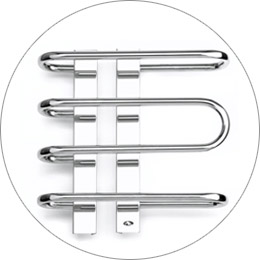
Despite its name, it collapses rather quickly. The exception is radiators with a wall thickness of 2-2.5 mm. Their cost is significantly higher.
Copper and brass
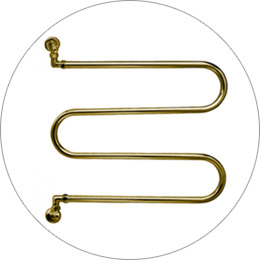
Of all the models have the highest heat dissipation. They can be successfully applied if the product certificate indicates that the inner surface of the pipes is galvanized and its connection to hot water systems is allowed.
Black steel
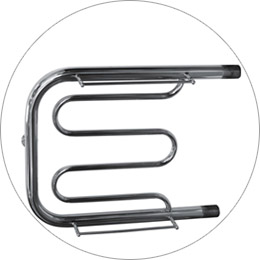
Black steel with anti-corrosion inner coating. This is the most reliable and durable option for a flowing heated towel rail connected to the hot water system.
Design selection
In addition to the classic, there are several types of heated towel rails and design radiators that solve the problem of connecting to a hot water supply, thanks to the original design. Such heating appliances are much more expensive than conventional ones, but their service life is practically unlimited, they warm the bathroom much better and can be used for other purposes year-round. We are talking about dual-circuit models of heated towel rails.
They are somewhat difficult to connect and differ in design, but effective in use. One of the circuits of such a device is connected to the DHW system. It has protection against high temperature, pressure and has a special protective, anticorrosive coating. Heat passing through the first circuit is transferred to the second circuit. Models of various sizes and designs are produced. Import manufacturers often coat the pipe walls with polymer protection from the inside. Such devices cannot be connected by soldering or using any other high-temperature effect.
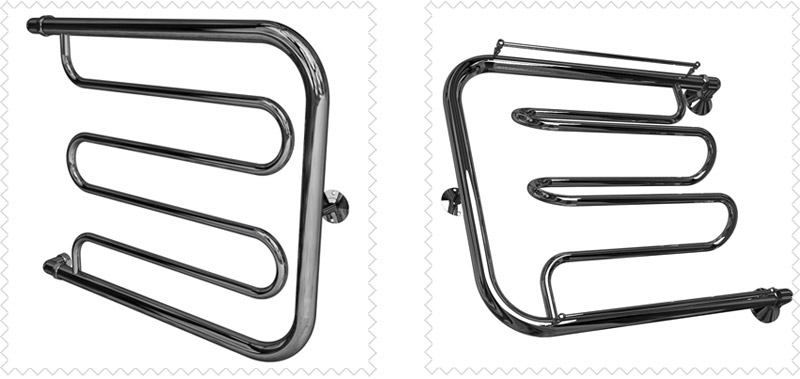
There are these devices and a slightly different device, which consists in the fact that the design of the radiator, made of thin-walled pipes, has its own gravitational heat exchanger. It is connected to a steel seamless thick-walled pipe, which cuts into the DHW system. Thus, the coolant circulating through the radiator of the heated towel rail is heated by hot water flowing through the pipe of the internal circuit, but the entire device is protected from the adverse effects of “aggressive” water from hot water and water hammer. This somewhat reduces the temperature of the radiator pipes at the outlet. But, due to the fact that the area of thermal radiation of the radiator is much larger than that of standard coils, the temperature in the bathroom will remain quite high.
In addition to all of the above, you need to pay attention to what kind of pipe supply you have and the distance between these pipes. The approach can be lower or lateral. Side approach can be right or left. Therefore, before choosing a particular model in the store, you must definitely clarify this point.
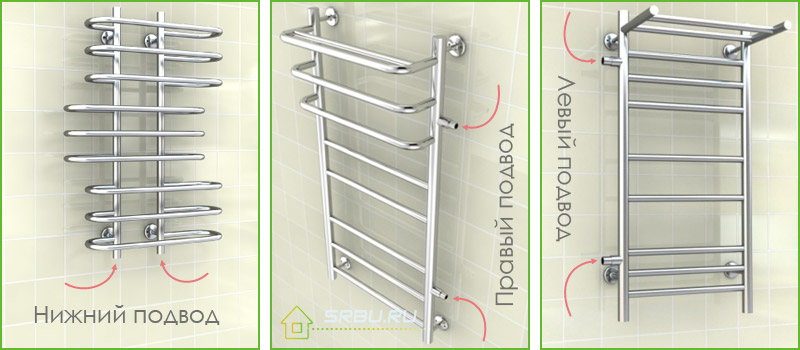
As for the distance between the pipes, it is usually 500 mm, but there are exceptions, so pay attention to this.
IMPORTANT! When buying a heated towel rail, which is planned to be connected to the hot water supply system, be sure to find information on the admissibility of such an application in the device passport. Otherwise, the financial cost of eliminating the consequences of a pipe breakthrough can be much more significant.
We choose the method of mounting and installing a heated towel rail
Another important point to pay attention to is the installation method. Although the installation of any heated towel rail is usually not the most difficult task, proper installation often requires the involvement of a qualified electrician or plumber (at least to maintain the manufacturer’s warranty), and this will increase your initially planned costs.
The easiest to install, especially when it comes to the work of non-professionals, are electric models with a plug. Most of them use a standard connector and can be connected to a wall outlet, like any other household appliance. From this point of view, those who are puzzled by the question of how to choose an electric heated towel rail for the bathroom may be moving on the right path.
There are three main types of heated towel rail installation:
Wall mounted
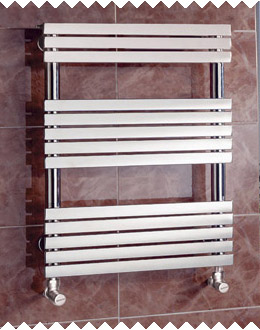
Both electric and water heated towel rails can be wall mounted.
Floor
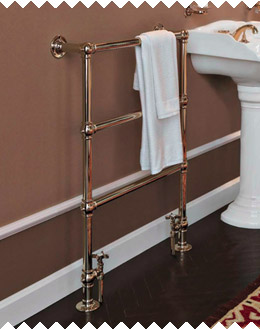
These are usually water towel rails.
Portable
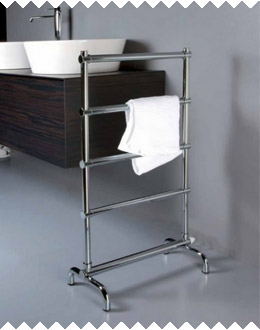
These are electrical devices that can be freely moved.
All water heated towel rails are mounted to the wall or floor, as they must be connected to the existing water supply system.
Wall mounted towel rails are a great option for rooms with limited floor space, where they can take the place of a conventional towel rail. Wall mounted models are available in water and electric versions.
When choosing between mounting a heated towel rail to a wall or floor, it is better to give preference to wall mounting. This is especially true for small bathrooms where a lot of appliances and furniture can be located on the floor. If in your bathroom only the lower part of the wall is tiled, you have to decide whether you want the heated towel rail to be located above or below the border, or you may be able to find a device that can be mounted on the wall with a level difference.
The portable heated towel rail provides greater flexibility in placement and use. In addition, its installation is very simple: even a person who has never held tools in his hands can cope with this! All portable heated towel rails are electric, just plug the plug into a power outlet to connect them.
If it comes to installing more complex heated towel rails, then this work should be delegated to a professional electrician or plumber. Electrical products are potentially at risk of fire and must therefore be installed in accordance with the requirements of the manufacturer.
Size and design
For each bathroom, you can choose a heated towel rail that fits perfectly into the interior! The list of styles is extensive - from classic to ultramodern.
Not the last role when choosing such an attention-grabbing element as a heated towel rail is assigned to its external coating. Some manufacturers prefer to use the most common polished brass or chrome as a coating today, but you can easily find design models, including those with the effect of aged bronze, antique gold, brushed nickel and much more. The most important thing is that your heated towel rail matches the style of your bathroom.
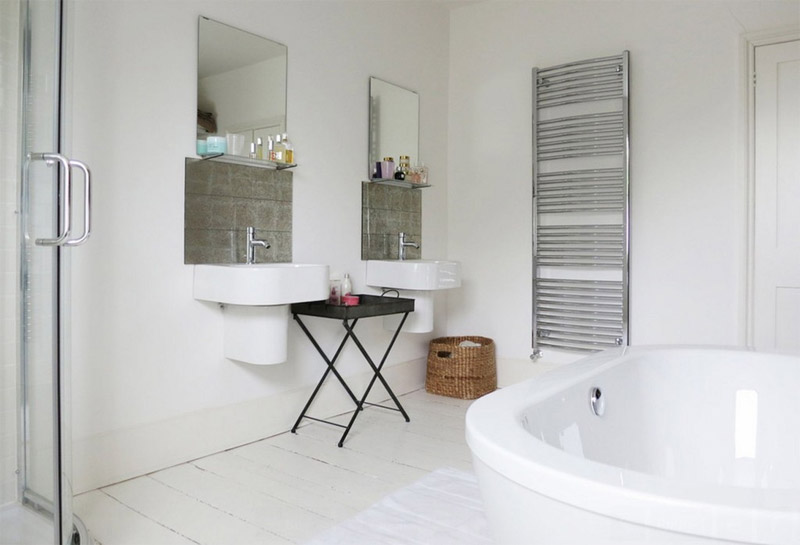
Large chrome heated towel rail.
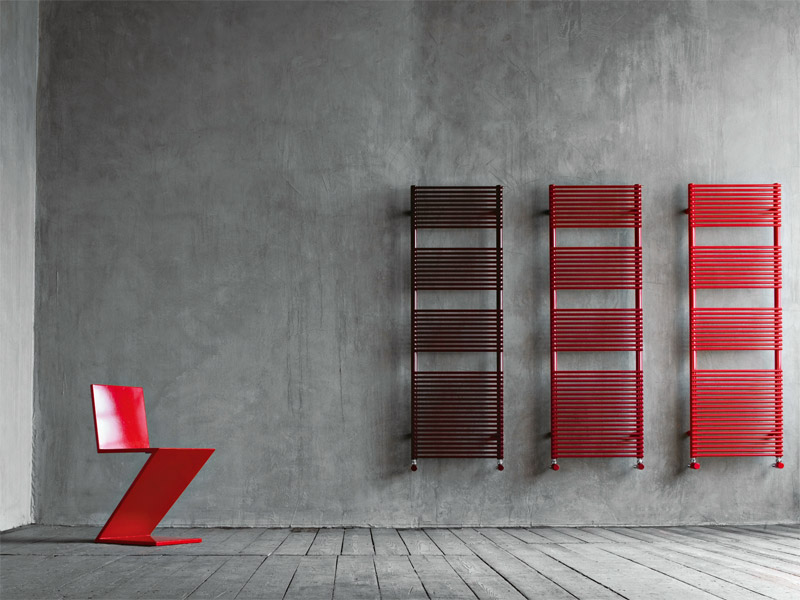
Design radiators painted in various colors.
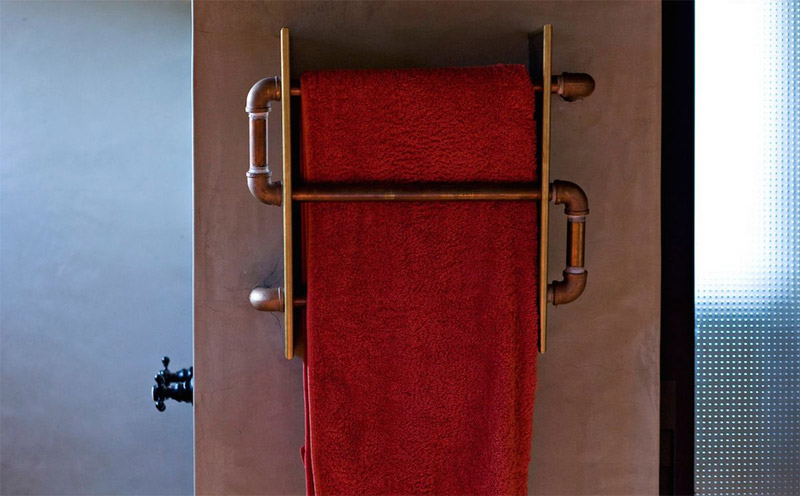
Heated towel rail in the old style.
Some towel warmers may include additional items, such as storage shelves and a coat hook. Think about how much these add-ons are really necessary for you, because abandoning unnecessary functions will save you a certain amount.
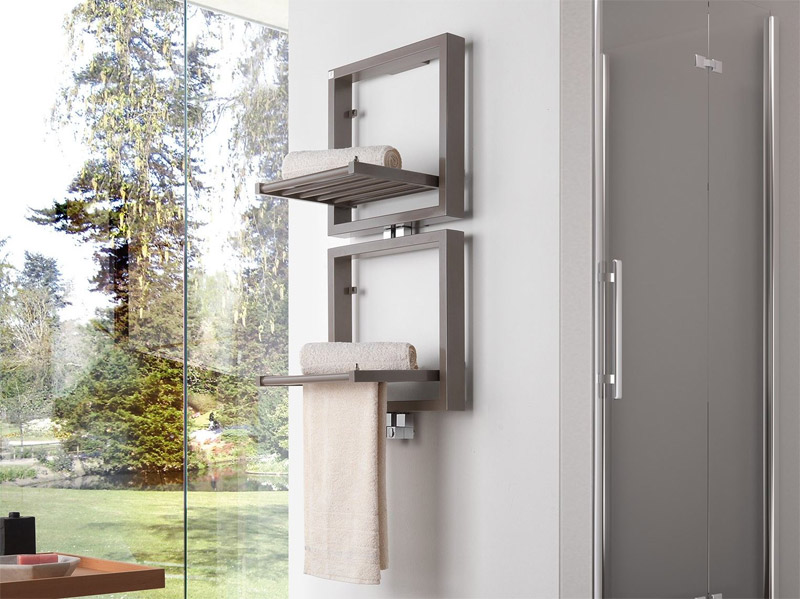
Heated towel rail in the form of two shelves, on which you can both put and hang towels and other things.
Pay attention not only to the performance style of your heated towel rail, but also to its size. How many towels will be dried on it at the same time? Will a too bulky device ruin the aesthetics of your room? It should be remembered that the larger the surface area of the heated towel rail, the faster the towels heat up and dry on it. If you want to not only dry towels, but also add warmth to your bathroom, you should give preference to a larger model.
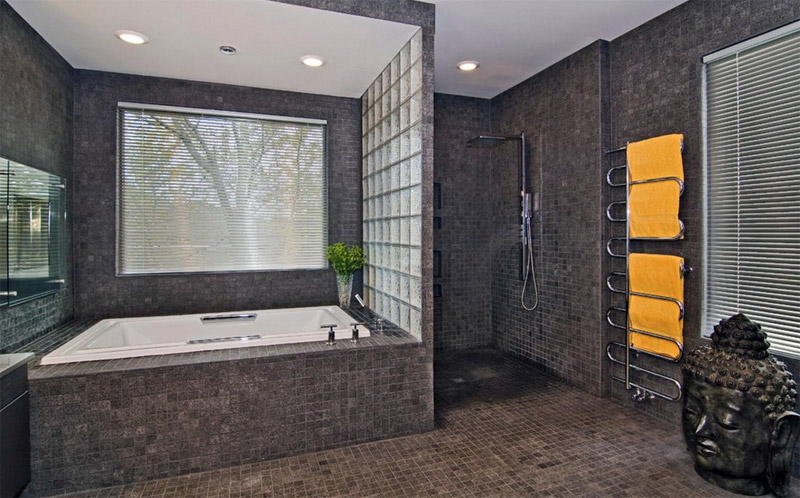
The large heated towel rail allows you to more spaciously hang out the things you need.
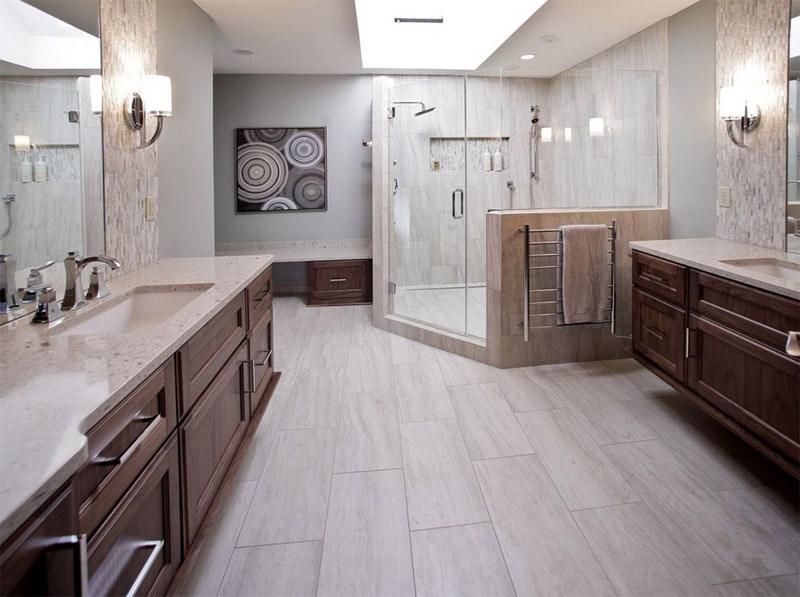
A small radiator can be placed in a fairly small space.
Additional functions - timers and switches
Modern heated towel rails are very energy efficient, and the most effective way to use them is to leave them on all the time. This is due to the fact that the energy required to heat an initially cold heated towel rail is much more than is necessary to maintain the heat of a device that has already been warmed up. Manufacturers, however, try to take into account the wishes of all users and equip their products with timers and shut-off switches.
Thanks to the presence of a timer, you can set your towel warmer to turn on long before taking a bath or shower, so that your towel is pleasantly warm when you finish washing. Some manufacturers install built-in timers or switches, others offer them as a separate option. Some models are also equipped with a thermostat to maintain the temperature of the heated towel rail according to your preference.
We tried to give you a general idea and help answer the question of how to choose a heated towel rail in the bathroom. We hope that this guide will help you in the decision-making process, and you will eventually find your ideal heated towel rail.
